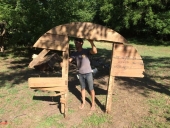Thank you John!
Hi Beau! I don't have a root cellar yet in my yard, as I'm still working on other projects, but my relatives and friends do, which is where I'm learning from hands on and there are also research papers available in Finnish to draw knowledge from if you need translating. I find your project very interesting and educational. Please keep us posted on your progress.
I know the humidity in a cellar can be very local and seasonal. Only observation will tell you what it is in each individual cellar. There used to be a consensus of letting the cellar air out during Spring and Summer, but that can lead to condensation inside the cellar as warm humid air touches the cool surfaces of the cellar, so the experts are now saying to keep the door closed as mold issues tend to come from too much moisture. How are you keeping the ground level moisture under control? You mentioned an additional air intake pipe being installed possibly. Will you be adding a drain at the same time?
I am planning on adding a cold storage room or "wine cellar" in my basement as my first food storage after working on my pantry. I will be insulating it from the heated part of the house and keeping the exterior wall as exposed cinder block, the floor is concrete. I will also be adding a low air intake and high exhaust to the room. The intake I'm planning on doing as an earth tube that drains any condensations in the pipe outwards of the house. I will also be learning as I go as to what the humidity levels are near the floor compared to the ceiling. Such a fun project be working on!






